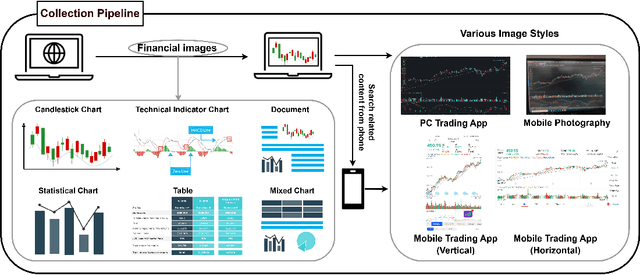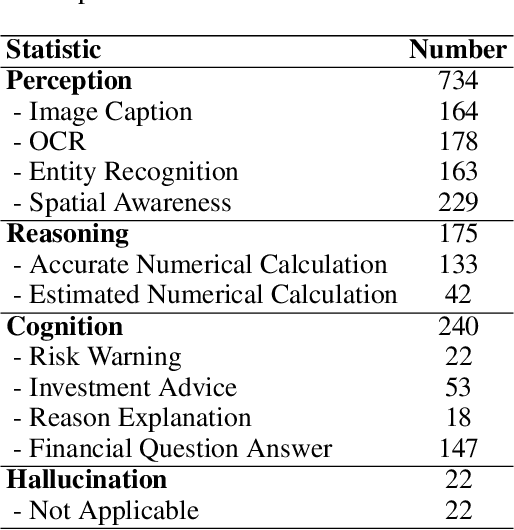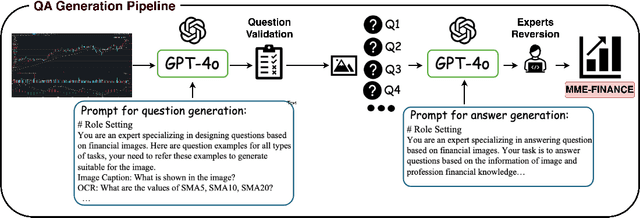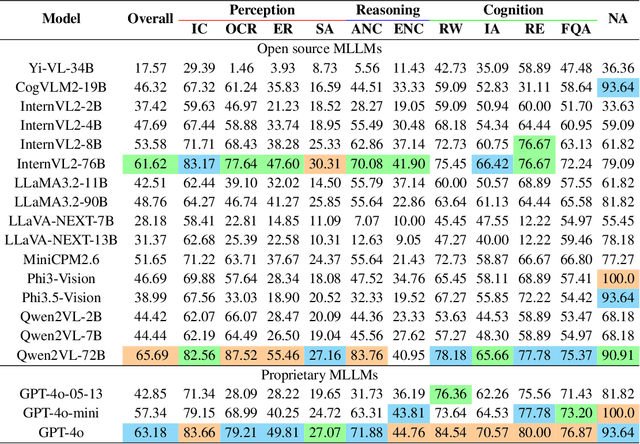Dong Zhang
Cyclic Contrastive Knowledge Transfer for Open-Vocabulary Object Detection
Mar 14, 2025Abstract:In pursuit of detecting unstinted objects that extend beyond predefined categories, prior arts of open-vocabulary object detection (OVD) typically resort to pretrained vision-language models (VLMs) for base-to-novel category generalization. However, to mitigate the misalignment between upstream image-text pretraining and downstream region-level perception, additional supervisions are indispensable, eg, image-text pairs or pseudo annotations generated via self-training strategies. In this work, we propose CCKT-Det trained without any extra supervision. The proposed framework constructs a cyclic and dynamic knowledge transfer from language queries and visual region features extracted from VLMs, which forces the detector to closely align with the visual-semantic space of VLMs. Specifically, 1) we prefilter and inject semantic priors to guide the learning of queries, and 2) introduce a regional contrastive loss to improve the awareness of queries on novel objects. CCKT-Det can consistently improve performance as the scale of VLMs increases, all while requiring the detector at a moderate level of computation overhead. Comprehensive experimental results demonstrate that our method achieves performance gain of +2.9% and +10.2% AP50 over previous state-of-the-arts on the challenging COCO benchmark, both without and with a stronger teacher model. The code is provided at https://github.com/ZCHUHan/CCKT-Det.
* 10 pages, 5 figures, Published as a conference paper at ICLR 2025
Taking A Closer Look at Interacting Objects: Interaction-Aware Open Vocabulary Scene Graph Generation
Feb 06, 2025Abstract:Today's open vocabulary scene graph generation (OVSGG) extends traditional SGG by recognizing novel objects and relationships beyond predefined categories, leveraging the knowledge from pre-trained large-scale models. Most existing methods adopt a two-stage pipeline: weakly supervised pre-training with image captions and supervised fine-tuning (SFT) on fully annotated scene graphs. Nonetheless, they omit explicit modeling of interacting objects and treat all objects equally, resulting in mismatched relation pairs. To this end, we propose an interaction-aware OVSGG framework INOVA. During pre-training, INOVA employs an interaction-aware target generation strategy to distinguish interacting objects from non-interacting ones. In SFT, INOVA devises an interaction-guided query selection tactic to prioritize interacting objects during bipartite graph matching. Besides, INOVA is equipped with an interaction-consistent knowledge distillation to enhance the robustness by pushing interacting object pairs away from the background. Extensive experiments on two benchmarks (VG and GQA) show that INOVA achieves state-of-the-art performance, demonstrating the potential of interaction-aware mechanisms for real-world applications.
Memory Efficient Transformer Adapter for Dense Predictions
Feb 04, 2025Abstract:While current Vision Transformer (ViT) adapter methods have shown promising accuracy, their inference speed is implicitly hindered by inefficient memory access operations, e.g., standard normalization and frequent reshaping. In this work, we propose META, a simple and fast ViT adapter that can improve the model's memory efficiency and decrease memory time consumption by reducing the inefficient memory access operations. Our method features a memory-efficient adapter block that enables the common sharing of layer normalization between the self-attention and feed-forward network layers, thereby reducing the model's reliance on normalization operations. Within the proposed block, the cross-shaped self-attention is employed to reduce the model's frequent reshaping operations. Moreover, we augment the adapter block with a lightweight convolutional branch that can enhance local inductive biases, particularly beneficial for the dense prediction tasks, e.g., object detection, instance segmentation, and semantic segmentation. The adapter block is finally formulated in a cascaded manner to compute diverse head features, thereby enriching the variety of feature representations. Empirically, extensive evaluations on multiple representative datasets validate that META substantially enhances the predicted quality, while achieving a new state-of-the-art accuracy-efficiency trade-off. Theoretically, we demonstrate that META exhibits superior generalization capability and stronger adaptability.
Deep Ensemble approach for Enhancing Brain Tumor Segmentation in Resource-Limited Settings
Feb 04, 2025Abstract:Segmentation of brain tumors is a critical step in treatment planning, yet manual segmentation is both time-consuming and subjective, relying heavily on the expertise of radiologists. In Sub-Saharan Africa, this challenge is magnified by overburdened medical systems and limited access to advanced imaging modalities and expert radiologists. Automating brain tumor segmentation using deep learning offers a promising solution. Convolutional Neural Networks (CNNs), especially the U-Net architecture, have shown significant potential. However, a major challenge remains: achieving generalizability across different datasets. This study addresses this gap by developing a deep learning ensemble that integrates UNet3D, V-Net, and MSA-VNet models for the semantic segmentation of gliomas. By initially training on the BraTS-GLI dataset and fine-tuning with the BraTS-SSA dataset, we enhance model performance. Our ensemble approach significantly outperforms individual models, achieving DICE scores of 0.8358 for Tumor Core, 0.8521 for Whole Tumor, and 0.8167 for Enhancing Tumor. These results underscore the potential of ensemble methods in improving the accuracy and reliability of automated brain tumor segmentation, particularly in resource-limited settings.
Generative Style Transfer for MRI Image Segmentation: A Case of Glioma Segmentation in Sub-Saharan Africa
Jan 07, 2025Abstract:In Sub-Saharan Africa (SSA), the utilization of lower-quality Magnetic Resonance Imaging (MRI) technology raises questions about the applicability of machine learning methods for clinical tasks. This study aims to provide a robust deep learning-based brain tumor segmentation (BraTS) method tailored for the SSA population using a threefold approach. Firstly, the impact of domain shift from the SSA training data on model efficacy was examined, revealing no significant effect. Secondly, a comparative analysis of 3D and 2D full-resolution models using the nnU-Net framework indicates similar performance of both the models trained for 300 epochs achieving a five-fold cross-validation score of 0.93. Lastly, addressing the performance gap observed in SSA validation as opposed to the relatively larger BraTS glioma (GLI) validation set, two strategies are proposed: fine-tuning SSA cases using the GLI+SSA best-pretrained 2D fullres model at 300 epochs, and introducing a novel neural style transfer-based data augmentation technique for the SSA cases. This investigation underscores the potential of enhancing brain tumor prediction within SSA's unique healthcare landscape.
Merging Context Clustering with Visual State Space Models for Medical Image Segmentation
Jan 03, 2025



Abstract:Medical image segmentation demands the aggregation of global and local feature representations, posing a challenge for current methodologies in handling both long-range and short-range feature interactions. Recently, vision mamba (ViM) models have emerged as promising solutions for addressing model complexities by excelling in long-range feature iterations with linear complexity. However, existing ViM approaches overlook the importance of preserving short-range local dependencies by directly flattening spatial tokens and are constrained by fixed scanning patterns that limit the capture of dynamic spatial context information. To address these challenges, we introduce a simple yet effective method named context clustering ViM (CCViM), which incorporates a context clustering module within the existing ViM models to segment image tokens into distinct windows for adaptable local clustering. Our method effectively combines long-range and short-range feature interactions, thereby enhancing spatial contextual representations for medical image segmentation tasks. Extensive experimental evaluations on diverse public datasets, i.e., Kumar, CPM17, ISIC17, ISIC18, and Synapse demonstrate the superior performance of our method compared to current state-of-the-art methods. Our code can be found at https://github.com/zymissy/CCViM.
Generalized Task-Driven Medical Image Quality Enhancement with Gradient Promotion
Jan 02, 2025



Abstract:Thanks to the recent achievements in task-driven image quality enhancement (IQE) models like ESTR, the image enhancement model and the visual recognition model can mutually enhance each other's quantitation while producing high-quality processed images that are perceivable by our human vision systems. However, existing task-driven IQE models tend to overlook an underlying fact -- different levels of vision tasks have varying and sometimes conflicting requirements of image features. To address this problem, this paper proposes a generalized gradient promotion (GradProm) training strategy for task-driven IQE of medical images. Specifically, we partition a task-driven IQE system into two sub-models, i.e., a mainstream model for image enhancement and an auxiliary model for visual recognition. During training, GradProm updates only parameters of the image enhancement model using gradients of the visual recognition model and the image enhancement model, but only when gradients of these two sub-models are aligned in the same direction, which is measured by their cosine similarity. In case gradients of these two sub-models are not in the same direction, GradProm only uses the gradient of the image enhancement model to update its parameters. Theoretically, we have proved that the optimization direction of the image enhancement model will not be biased by the auxiliary visual recognition model under the implementation of GradProm. Empirically, extensive experimental results on four public yet challenging medical image datasets demonstrated the superior performance of GradProm over existing state-of-the-art methods.
Parameter-efficient Fine-tuning for improved Convolutional Baseline for Brain Tumor Segmentation in Sub-Saharan Africa Adult Glioma Dataset
Dec 18, 2024Abstract:Automating brain tumor segmentation using deep learning methods is an ongoing challenge in medical imaging. Multiple lingering issues exist including domain-shift and applications in low-resource settings which brings a unique set of challenges including scarcity of data. As a step towards solving these specific problems, we propose Convolutional adapter-inspired Parameter-efficient Fine-tuning (PEFT) of MedNeXt architecture. To validate our idea, we show our method performs comparable to full fine-tuning with the added benefit of reduced training compute using BraTS-2021 as pre-training dataset and BraTS-Africa as the fine-tuning dataset. BraTS-Africa consists of a small dataset (60 train / 35 validation) from the Sub-Saharan African population with marked shift in the MRI quality compared to BraTS-2021 (1251 train samples). We first show that models trained on BraTS-2021 dataset do not generalize well to BraTS-Africa as shown by 20% reduction in mean dice on BraTS-Africa validation samples. Then, we show that PEFT can leverage both the BraTS-2021 and BraTS-Africa dataset to obtain mean dice of 0.8 compared to 0.72 when trained only on BraTS-Africa. Finally, We show that PEFT (0.80 mean dice) results in comparable performance to full fine-tuning (0.77 mean dice) which may show PEFT to be better on average but the boxplots show that full finetuning results is much lesser variance in performance. Nevertheless, on disaggregation of the dice metrics, we find that the model has tendency to oversegment as shown by high specificity (0.99) compared to relatively low sensitivity(0.75). The source code is available at https://github.com/CAMERA-MRI/SPARK2024/tree/main/PEFT_MedNeXt
Divide-and-Conquer: Confluent Triple-Flow Network for RGB-T Salient Object Detection
Dec 02, 2024Abstract:RGB-Thermal Salient Object Detection aims to pinpoint prominent objects within aligned pairs of visible and thermal infrared images. Traditional encoder-decoder architectures, while designed for cross-modality feature interactions, may not have adequately considered the robustness against noise originating from defective modalities. Inspired by hierarchical human visual systems, we propose the ConTriNet, a robust Confluent Triple-Flow Network employing a Divide-and-Conquer strategy. Specifically, ConTriNet comprises three flows: two modality-specific flows explore cues from RGB and Thermal modalities, and a third modality-complementary flow integrates cues from both modalities. ConTriNet presents several notable advantages. It incorporates a Modality-induced Feature Modulator in the modality-shared union encoder to minimize inter-modality discrepancies and mitigate the impact of defective samples. Additionally, a foundational Residual Atrous Spatial Pyramid Module in the separated flows enlarges the receptive field, allowing for the capture of multi-scale contextual information. Furthermore, a Modality-aware Dynamic Aggregation Module in the modality-complementary flow dynamically aggregates saliency-related cues from both modality-specific flows. Leveraging the proposed parallel triple-flow framework, we further refine saliency maps derived from different flows through a flow-cooperative fusion strategy, yielding a high-quality, full-resolution saliency map for the final prediction. To evaluate the robustness and stability of our approach, we collect a comprehensive RGB-T SOD benchmark, VT-IMAG, covering various real-world challenging scenarios. Extensive experiments on public benchmarks and our VT-IMAG dataset demonstrate that ConTriNet consistently outperforms state-of-the-art competitors in both common and challenging scenarios.
MME-Finance: A Multimodal Finance Benchmark for Expert-level Understanding and Reasoning
Nov 05, 2024



Abstract:In recent years, multimodal benchmarks for general domains have guided the rapid development of multimodal models on general tasks. However, the financial field has its peculiarities. It features unique graphical images (e.g., candlestick charts, technical indicator charts) and possesses a wealth of specialized financial knowledge (e.g., futures, turnover rate). Therefore, benchmarks from general fields often fail to measure the performance of multimodal models in the financial domain, and thus cannot effectively guide the rapid development of large financial models. To promote the development of large financial multimodal models, we propose MME-Finance, an bilingual open-ended and practical usage-oriented Visual Question Answering (VQA) benchmark. The characteristics of our benchmark are finance and expertise, which include constructing charts that reflect the actual usage needs of users (e.g., computer screenshots and mobile photography), creating questions according to the preferences in financial domain inquiries, and annotating questions by experts with 10+ years of experience in the financial industry. Additionally, we have developed a custom-designed financial evaluation system in which visual information is first introduced in the multi-modal evaluation process. Extensive experimental evaluations of 19 mainstream MLLMs are conducted to test their perception, reasoning, and cognition capabilities. The results indicate that models performing well on general benchmarks cannot do well on MME-Finance; for instance, the top-performing open-source and closed-source models obtain 65.69 (Qwen2VL-72B) and 63.18 (GPT-4o), respectively. Their performance is particularly poor in categories most relevant to finance, such as candlestick charts and technical indicator charts. In addition, we propose a Chinese version, which helps compare performance of MLLMs under a Chinese context.
 Add to Chrome
Add to Chrome Add to Firefox
Add to Firefox Add to Edge
Add to Edge